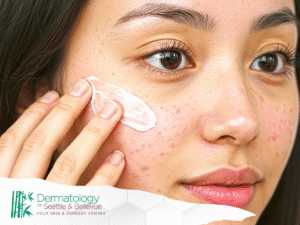Seattle’s long summer days and occasional heat can give the impression that UV exposure here is mild—but that isn’t the case. Even under cool temperatures and patchy cloud cover, UV radiation penetrates the atmosphere and poses a measurable risk to your skin. Over time, cumulative UV damage increases your overall risk of premature aging and skin cancer.
Our region’s latitude and reflective surfaces (like water and concrete) can elevate local uv index readings compared with what you might expect from a quick glance at the temperature. Staying aware of both the index and actual radiation levels is key to healthy summer habits.
How uv radiation affects your skin in summer
UV radiation consists of UVA and UVB rays, each impacting skin health in different ways. While UVA penetrates more deeply—contributing to aging and DNA changes—UVB is the main culprit behind sunburn. In Seattle’s summer months, both types are present:
- UVA can accelerate fine lines and wrinkles even on cloudy days.
- UVB intensity peaks between late morning and early afternoon, increasing sunburn risk.
Your skin’s natural defenses (melanin production and repair enzymes) work overtime in the summer. Prolonged exposure, however, overwhelms these systems, leading to redness, inflammation, and long-term cellular damage.
Interpreting the uv index in seattle
Understanding the uv index is your first step toward practical sun protection. The index is a standardized measure—from 0 (minimal) to 11+ (extreme)—that reflects the strength of UV radiation at solar noon. In Seattle:
- Low (0–2): Minimal risk; basic protection suffices.
- Moderate (3–5): Wear sunscreen and a hat for outdoor activities.
- High (6–7): Seek shade during peak time of day; reapply sunscreen every two hours.
- Very High (8–10): Limit direct sun; use broad-spectrum sunscreen of SPF 30+.
- Extreme (11+): Avoid prolonged exposure; cover up with sun-protective clothing.
Even on cloudy days, scattered radiation can push the index into Moderate or High territory—so consulting daily forecasts and local tools will help you calibrate your routine.
How to read the uv index scale
The uv index scale translates complex uv radiation data into a simple number you can use to plan outdoor activities. It’s calculated based on factors like sun angle, ozone levels, and ground reflection. Here’s what to look for: lower index values mean less incoming uv radiation at the time of measurement, while higher values signal a greater risk of skin damage. When you check your local forecast, note both the peak index and the time of day it applies to—this helps you gauge how long you can safely stay outside without adequate sun protection.
What summer months mean for uv exposure
In Seattle, summer months bring longer daylight hours and a higher sun angle, both of which boost overall uv radiation levels. Even if temperatures hover in the 60s or 70s, the combination of extended midday sun and reflective surfaces (like Puget Sound) can amplify your cumulative uv dose. During June through August:
- Average daily uv index often reaches Moderate to High levels.
- Extended outdoor events—festivals, beach trips, hikes—mean more prolonged skin exposure.
- Routine activities (walking the dog, gardening) add up, increasing your long-term risk of photodamage and premature aging.
Planning your summer around uv peaks will let you enjoy sunny days while minimizing unnecessary skin risk.
Cloud cover doesn’t block uv rays
It’s a common misconception that overcast skies protect you from uv radiation. In reality, up to 80% of uv rays penetrate thin cloud cover, and broken clouds can even focus sunlight onto your skin. On cloudy days:
- You may not feel the heat, but your skin still absorbs harmful uv radiation.
- The risk of sunburn can be just as high as on clear days, especially if uv levels spike unexpectedly.
- Relying on shade alone isn’t enough—supplement with broad-spectrum sunscreen and protective clothing.
• Check real-time uv levels via smartphone apps before heading out.
• Reapply sunscreen every two hours, even when you don’t see direct sun.
• Wear hats and long sleeves when possible to create a consistent barrier against invisible radiation.
Peak time of day for maximum radiation levels
UV radiation peaks when the sun is highest in the sky—typically between 11 AM and 3 PM. During these hours, the shorter path through the atmosphere means less scattering and absorption, so more UVB and UVA reach your skin. If you must be outdoors:
- Plan strenuous activities for early morning or late afternoon.
- Seek shade to lower direct exposure during peak radiation levels.
Understanding sunburn risk on cloudy days
Even when clouds obscure the sun, your skin remains vulnerable to UVB. Thin or broken cloud cover can scatter UV rays, leading to a deceptive “cool but burning” effect. Watch for:
- Sudden increases in UV index without noticeable brightness.
- Lingering redness hours after outdoor exposure.
Maintaining sun protection routines—hat, sunglasses, and sunscreen—is crucial, regardless of visible sunshine.
Choosing the right sunscreen for sun protection
Selecting and applying sunscreen correctly offers your best line of defense against harmful UV radiation. Keep these guidelines in mind:
- Broad-spectrum SPF 30+ protects against UVA and UVB.
- Water-resistant formulas are essential if you’re sweating or swimming.
- Generous application: A shot-glass full for your body and a nickel-sized dollop for your face.
- Reapplication every two hours, or immediately after towel-drying.
- Don’t forget ears, neck, and tops of feet, where UV exposure can be high.
Beyond sunscreen: shade and protective clothing
While sunscreen is vital, combining it with physical barriers amplifies your protection against UV radiation. Seeking shade—especially under trees, umbrellas, or canopies—reduces direct exposure to strong UV rays. Clothing made from tightly woven fabrics, long sleeves, wide-brimmed hats, and UV-blocking sunglasses all serve as practical, wearable shields during outdoor activities.
Monitoring uv levels with tools and indexes
Staying informed about real-time UV levels empowers you to adjust plans and gear accordingly. Numerous smartphone apps and local weather sites report the current UV index and forecasted radiation levels. By checking the index before heading out, you can determine the safest time of day for outdoor play or work, even on cloudy days when radiation can still be high.
Reducing your risk of skin cancer year-round
Protecting your skin consistently throughout the year lowers your overall risk of skin cancer, not just during summer months. Incorporate these habits into your routine to guard against cumulative UV damage:
- Wear broad-spectrum sunscreen (SPF 30+) daily, reapplying every two hours.
- Use shade structures and protective clothing—hats, long sleeves, and UV-blocking fabrics.
- Schedule outdoor activities outside peak time of day (11 AM–3 PM) when UV radiation levels spike.
- Monitor the UV index with reliable tools and plan accordingly.
- Perform regular skin self-exams and consult a dermatologist for any changing spots or moles.
Disclaimer:
This information is for educational purposes only and does not replace professional medical advice. Always consult a qualified dermatologist or healthcare provider for personalized recommendations and before starting any new sun protection regimen.





